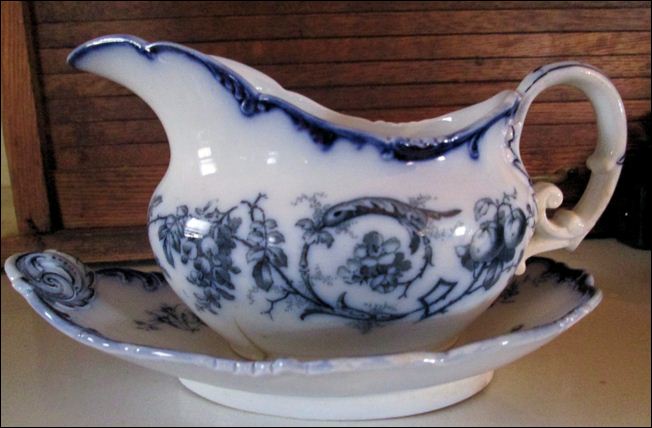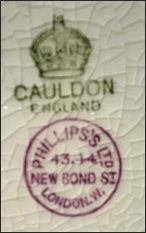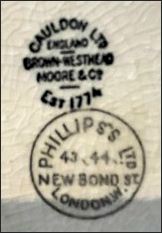![]()
|
Cauldon Ltd Cauldon
(Brown-Westhead, Moore & Co) Ltd
|
Location and period of operation:
|
Cauldon Ltd |
Hanley |
1904 |
1920 |
|
China and earthenware manufacturer at Cauldon Place Works, Shelton (Hanley), Stoke-on-Trent
|
Previously: Brown-Westhead Moore & Co. [1862-1904]
Subsequently: Cauldon Potteries Ltd. [1920-62]
Cauldon Place

Cauldon (Brown-Westhead,
Moore & Co), Limited,
Caludon Place Works. China, earthenware and
sanitary ware manufacturers
from..... 1907
Staffordshire Sentinel
'Business Reference Guide to The Potteries, Newcastle & District'
|
CAULDON WORKS "I WAS instructed to pay a short visit to Cauldon (Brown-Westhead, Moore & Co), Limited, at Stoke-on-Trent. They are manufacturers of the high-grade pottery known the world over as "Cauldon China". They call their pottery "Cauldon Works", and they are situated at Cauldon-place. It would appear to anyone unacquainted with the facts that the use of the word "Cauldon" was developed in the order in which I have just mentioned it. I find it has been in the reverse order. There was a pottery in Cauldon-place at the end of the eighteenth century, and early in the nineteenth - that is to say, in 1802 - Mr. Job Ridgway erected a new manufactory there and called it "Cauldon Works".
The firm adopted the name "Cauldon China" for their porcelain productions - a name which has become famous. But they make practically every other description of pottery: china tea, breakfast, and dessert services, earthenware dinner and toilet services, ornamental goods in china and parian, plain and ornamental sanitary ware. The manufacture of all these is continued, and now, as always, the productions of Cauldon Works, from the plain printed earthenware dinner plate to the most ornate china vase, are noted for the superiority and soundness of body, the clear glaze, and the superb finish. In 1877 they produced a magnificent china dessert service for the Prince of Wales (now King Edward VII.), each piece decorated with a unique and finely painted hunting scene. They also supplied dinner, dessert, tea, and breakfast services for the Czar of Russia. It is interesting to notice that the orders for the Czar were secured in competition with Sevres, Dresden, and other famous manufactories. They have exhibited at most, if not all, of the great international exhibitions, and have taken the highest honours obtainable. Four years ago the firm was converted into a limited liability company, under the name of "Cauldon (Brown-Westhead, Moore & Co.) Limited". Thus it has happened that the company has taken its name from its production, "Cauldon China", The china was named from the works at which it was made, and the works were called after the place on which they were built. It was called "Cauldon" for generations before pots were made there. Cauldon china will give the name an even longer life in the future than it has had in the past.
Although it is now a company, the business is still controlled by that hereditary personal ability which made it famous. On the directorate are Mr. Frederick T. Moore, Mr. Joseph Harrison, Mr. H. J. Warrington, and Mr. John Leyland, whilst Mr. P. B. Ross is secretary. During my recent visit I was favoured with a short interview with Mr. F. T. Moore, who had only just returned from a visit to the United States in the interests of the company. As Mr. Moore had seen many show rooms which I also had visited, I am sorry we had not time for a longer chat about our trade in the States. Mr. Moore is a keen observer, and I am sure he has gathered much information that will enable his company to increase their American connection. I incidentally asked him if he had visited a certain pottery. "No, I did not", he said, with a smile. "I was not there so much for seeing potteries - I see enough of them here; I was looking up our agents and customers, and ascertaining exactly the class of goods they wanted". At the time of my visit, Mr. John Leyland, who has been so long associated with the firm, was away on the Continent, visiting their various agencies and customers. On his return he will take up his residence in town as London Director. Mr. Moore left me soon, but I had a long interview with several of the heads of departments. Mr. T. Beresford, the works manager, showed me over parts of the works, and I noticed numerous additions and alterations since I was last there. He introduced me to Mr. P. B. Ross, the secretary, and between them they gave me details of the changes that have recently taken place in connection with the business.
It was explained to me that the new business contemplated will be in addition to, and is not intended to supplant, the class of trade so long and so successfully carried on. The production of high-class ornamental and useful china which has brought the company renown in the past will be continued, but at the same time more attention will be given to the useful but less costly productions in other departments of the works. I had an insight into this when I saw how admirably the company are equipped for supplying their special vitrified hotel ware. The stout plates with roll edges are practically unchippable, and they combine every feature that contributes to durability. This vitrified ware is specially suitable for railway, hotel, and restaurant purposes, and the company are developing this class of trade with considerable energy. I was introduced to Mr. S. P. Evans, the manager of the sanitary ware department. I was at once reminded of the wide field covered by the productions of Cauldon Works. Of course I know the company make sanitary ware, but I do not always bear it in mind so clearly as I do their beautiful artistic porcelain. No doubt there are many like me in this respect. If they could have a quarter of an hour with Mr. Evans as I had, and hear what he has to say, and see what he can show them about Cauldon sanitary ware, they would realise that this is not a mere "side line" but a substantial and important industry, conducted with as much energy and enterprise as though the prosperity of the company depended upon it. I am not an expert in sanitary pottery, so that I am afraid Mr. Evans would consider me a rather inappreciative visitor; but I can assure him I was greatly interested in his department. Since my return I find (and it may be useful for others to know) that sanitary ware has been a speciality of the Cauldon Works for more than half a century. Long ago they held numerous patents for improvements in the production of it, and in 1873 they were awarded a medal for their general excellence in it at the International Exhibition in Vienna. In addition to the two special lines I have described, the company hope and believe that the new arrangements just made all through their works, coupled with the improved plant they have installed, will enable them to produce inexpensive goods - useful and fancy - so as to compete successfully with those now on the home and in foreign markets.
Although the gentlemen who received me at the works appeared desirous of talking to me more about the extension of their productions in substantial, useful, and inexpensive goods, I felt, and made no attempt to conceal my partiality for the artistic branches of their many-sided business. I am sorry time did not permit me to seek a short interview with some of their decorative artists. I saw their work in the show room. I am referring not merely to the purely ornamental pieces, but to the neat and tasteful ornamentations of dinner ware, dessert services and tea and breakfast sets. They are showing an attractive variety of toilet services in quite new forms. I was shown a great number of new forms and decorations in dinner ware. The company are very strong in this line, and their new decorations are of an interesting variety. In Fig. 1 we give illustrations of a meat dish, a cover dish and dinner plate, with a pretty festoon border. This makes a pretty set, either printed or enamelled. Fig. 2 shows a good selling line in dinner and tea ware. It has a plain band in blue, and is supplied with or without gold. The band can also be had in other colours. These two patterns indicate the popular lines on which the company are developing their business. When in Mr. Beresford’s office I noticed on his table two or three samples of dinner plates with beautiful borders in rich combinations of colour and traced gold. 1 intended to handle them and to ask some questions about them, but other matters diverted my attention. We also give an illustration of the splendid show room at Cauldon Works, one of the best in the Potteries. It is a magnificent room, with artistic architectural features specially introduced. The noble arch at the end of the room with the two figures on stands in recesses at the sides is very effective. The arrangement of the samples is judicious for a sale room, artistic as a show room. Useful domestic ware occupies tables and stands in the centre of the room, while richly ornamented art pieces are in glass cases at the sides, with busts and vases on the top of the cases and plaques on the walls. Cauldon china is, of course, seen to perfection in a multiplicity of forms, both useful and ornamental. Its rich creamy body, beautiful glaze, and brilliantly coloured paintings are characteristics well known to most of our readers." The Pottery Gazette - January 1908 |

Cauldon Limited Brown-Westhead,
Moore & Co
(Late John Ridgway - Established 1774)
Cauldon Place Works, Stoke-on-Trent
China, Table, Dessert & Tea Ware
The Pottery Gazette - January 1st 1913

Cauldon Sanitary Porcelain
Grand Prix Paris 1889
Cauldon sanitary ware advert for the Dutch market


gravy boat and saucer with the
mark 'CAULDON PLACE, ENGLAND'
and registration number 184291
the registration numbers shows
that the pattern was originally registered by the
preceding company of Brown-Westhead Moore &
Co

Cauldon Ltd dinner plate
 transfer printed wash basin "sanitary ware has been a speciality of the Cauldon Works for more than half a century. Long ago they held numerous patents for improvements in the production of it, and in 1873 they were awarded a medal for their general excellence in it at the International Exhibition in Vienna" |

printed mark incorporating the Royal Arms R.S.S.& S. was probably a distributor
the impressed 10 06 gives the
manufacturing |
photos courtesy: Krista Wander
 Cauldon Ltd - gilded soup bowl and plate |
 Cauldon Ltd - gilded trio of plate, cup and saucer |


the plates and saucer have the left hand mark 'Cauldon Ltd'
and the cup has the right hand mark 'Cauldon China'
 bowls with embossed, gilded border and cobalt blue band photos courtesy: Wendy Nord |
 Cauldon Ltd J. McD & S Co. Brown-Westhead Moore & Co |
|
J. McD & S Co. were American importers and wholesalers - in 1871 Jones, McDuffee and Stratton became the owners of The Boston Company (established 1810). By 1910 they were the largest wholesaler and retailer of china and glassware in the United States. They imported quality English pottery, porcelain, and bone china from such companies as Wedgwood, Brown-Westhead, Moore & Co, Royal Worcester. Jones, McDuffee and Stratton' were known by that name until it ceased to exist after it celebrated its 150th anniversary in 1960. |

 Cauldon England |
 Cauldon Ltd England Brown-Westhead Moore & Co Est 1774 |
photos courtesy: Kym McIlroy
Cauldon dinner service distributed by the London Retailers Phillips's Ltd
Cauldon - Oak Leaf Pattern



Real Cauldon China
Reproduction of a Cauldon Pattern made about 1805
Reg No 640003
|
In 1802 Job Ridgway built a new manufactory in Shelton, Stoke-on-Trent and called it "Cauldon Works" - it was at these works that Job created this 'Oak Leaf' pattern which was resurrected in 1914 by Cauldon (Brown-Westhead Moore & Co.) Ltd. who, at the time, were trying to improve their financial position and save the business from bankruptcy. The design consists of a white ground with gilt rim and decoration of stylized oak leaves and tendrils over a single background colour. There are three Rococo style reserves of hand painted polychrome flowers. The rim background colour varied and was produced in a range of colours including bright pink, salmon pink, dark cobalt blue, light mustard yellow, grey and green. The registration number 640003 shows that this Cauldon reproduction was first registered in 1914. Although not certain it is unlikely that the pattern, which was time consuming and costly to produce, was continued after 1920. The 'Oak Leaf' pattern was stocked by some prestigious retailers including Jenners of Edinburgh, Thomas Goode of London and Tiffany & Co of New York. |
|
Cauldon |
Jenners
Edinburgh |
Tiffany
& Co |
various marks were used on the 'Oak Leaf' pattern
1914 - c. 1920
Marks used on ware for identification:
A
variety of marks were used by this company including some earlier Ridgway
marks ('J.R.' 'J.R. & Co.').
Where these marks include 'Cauldon Ltd.' they are definitely from the
1904-20 period.
Marks which include 'Cauldon Place' are likely to have been used early in the business of Cauldon Ltd.
The mark 'Cauldon China - Estd 1774' was used by Cauldon Ltd.
|
Why is some of the Cauldon ware marked "Est 1774"? First fact:
Cauldon Ltd were in operation from c.1904-1920.
|

CAULDON PLACE
ENGLAND
Rd No 184291
the registration number shows that the pattern was registered in 1891
'Cauldon Place' appears to be
a mark used early in the
business of Cauldon Limited


CAULDON
ENGLAND
printed mark CAULDON
some marks include 'Ltd' or 'Limited'

CAULDON Ltd
ENGLAND

ESTd 1774
CAULDON CHINA
ENGLAND

plate with both the printed
mark 'CAULDON PLACE ENGLAND'
and impressed mark 'CAULDON'

plate with both the printed
mark 'CAULDON Ltd ENGLAND'
and impressed mark 'CAULDON'

CAULDON Ltd ENGLAND
Burley & Co Chicago
Chintz J R & Co
Regd No 599628
This mark of Cauldon Ltd makes
use of a belt-mark used by
John Ridgway & Co [J R & Co] (who operated at the Cauldon Works 1830-55)
The registration number 599628 indicates a registration date of 1912
Burley & Co, Chicago were American importers of pottery and glass ware

Stone Ware
J R
Corinthian Flute
CAULDON ENGLAND
Corinthian Flute is the pattern name
This mark of Cauldon Ltd
(1904-20) makes
use of a previous belt-mark used by
John Ridgway [J R] (who operated at the Cauldon Works 1830-55)
- click picture for more -
 The Pottery Gazette - June 1906 |
Recent Company Liens Registered. Cauldon (Brown-Westhead, Moore & Co.), Ltd., Stoke-on-Trent. — The issue has been registered of £1,000 5 per cent, debentures, part of a series created to secure £40,000, charged on the copyhold canal wharf, offices and earthenware factory at Cauldon-place, Stoke-on-Trent, and site thereof (subject to mortgage dated November 1, 1865), copyhold land at Shelton, and the company’s undertaking and property, present and future, including uncalled capital. Total amount previously issued of same series, £27,000. |
 The Pottery Gazette - November 1908 |
Some misapprehension seems to have arisen in certain quarters regarding the notices which havo been posted at the works of Cauldon, Ltd., informing the workpeople that "every one employed on these works will be under one month’s notice from this date." The notices are dated October 24, and add that "during the month each person will be seen with a view to possible rearrangement of their work and wages." Naturally, the posting of these notices caused a good deal of anxiety, for Cauldon Place is one of the largest, oldest, and most justly renowmed works in the Potteries. I am glad, therefore, to be able to say, on official authority, that there is no reason to suppose that the works is to be closed down, even for a period. It is no secret that Cauldon, Ltd., like most other firms engaged in the industry, has, for some time past, been feeling the effect of the general depression and keen competition, and, as the notices show, certain retrenchments are now to be made. It is stated that the rate of wages paid by Cauldon Ltd. — or, as the Company was known until recently, Brown, Westhead, Moore & Co. — has been fully up to the standard, and even above that paid by most manufacturers in the district. This being the case, it is easy to understand that the directors, at a period when trade is so depressed, are anxious, if possible, to effect a rearrangement of the work and wages of their employees. Everyone will trust that the steps which are being taken may be attended by beneficial results, and that a long era of prosperity lies before the famous works. |
The London Gazette
July 4, 1911

Cauldon
(Brown-Westhead Moore & Co.) Ltd.
notice of meetings under the Companies
(Consolidation) Act
the result
was that in July 1912 the capital and number
of shares in the company were reduced
Questions, comments, contributions? email: Steve Birks